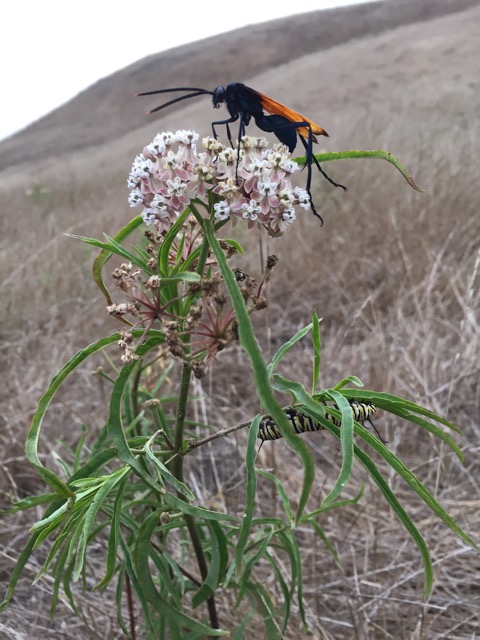
Our local larval host plant for the monarch butterfly, the narrowleaf milkweed, feeds baby butterflies (caterpillars) and more. The tarantula hawk (in photo) also visits for a snack. Strong alkaloids in milkweed’s leaves can be poisonous to some herbivores, like cattle, but can be critical to feeding insects who evolved to tolerate ingested toxins as protection from predation. This is why some species, like monarchs, need specific larval hosts — they cannot live without the combination of food source, alkaloid tolerance and its poisonous armor.
The narrowleaf milkweed adds summer flowers to gardens and claims a home in diverse habitats across California. The perennial herb rises three feet tall and adapts to a wide range of soils, wetness and exposure. With sufficient sunlight, lavender-tinted white flower clusters bloom atop thin, erect stems through summer drought from June to September. Fruit pods split to reveal fluffs of abundant silky threads which disperse and propagate. In winter, birds use dead stems to build nests.
For habitat benefits and seasonal interest to take hold in your garden, plant narrowleaf milkweed in drifts or bunches with plentiful summer sun and give plants a few years to mature. Monarchs usually lay one egg on a single leaf tip, but may lay up to 1000 eggs over 2-5 weeks. So the more leaves the better for attracting butterflies! See UMN Monarch Lab’s for info on the monarch’s life cycle.
Plants need 2-3 years of growth to fully leaf out, support blooms and form seed pods. New plantings require patience and then once established, seeds spread, sometimes into dense and expansive patches. Beds may need annual thinning to keep in check but also offer more food and tempting habitat for hungry caterpillars.